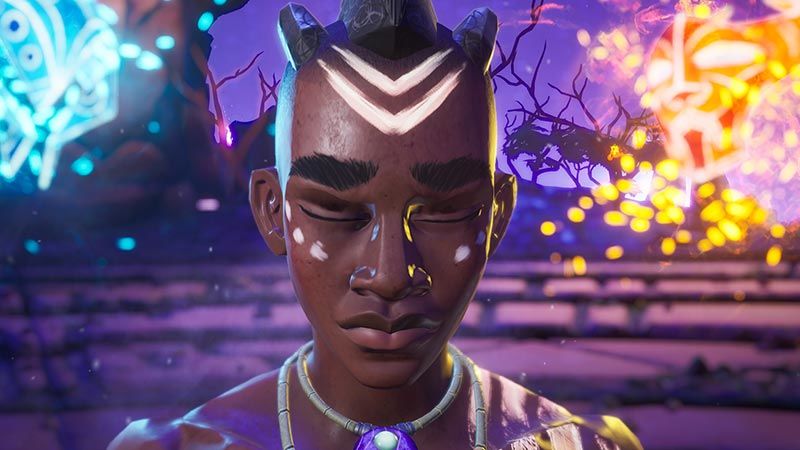In our Tales of Kenzera: Zau review article, we take an in-depth look at the independent game in the Metroidvania genre.
Tales of Kenzera: Zau ReviewTales of Kenzera, set in three different regions, opens with a story of disappearance. In real life, Abubakar Salim, CEO and creative director of Surgent Studios, lost his father and felt the need to create a work of art to cope with this pain. In the part where the play takes place, young Zuberi, who lives in Amani, an Afrofuturist paradise, also lost his father and his son inherited a legendary book written by his father on his deathbed. The last part of the game and playable story is about the adventures of Zau, a young shaman who lost his father.
Tales of Kenzera: Zau Review / PC
But he chooses a more radical method to deal with Zau’s grief: He reaches out to Kalunga, the God of Death, a being who appears in the form of a tribal elder, and bargains with him to bring his father’s soul back from the grave. Kalunga says he will help Zau, and in return, he asks Zau to go after three divine spirits who refuse to go gently into that beautiful night when the time has come.
With this deep thematic structure, Tales of Kenzera is a slight disappointment in some ways. Zau’s story basically plays out as a very simple Metroidvania, and the game’s platforming and puzzle mechanics are not effective enough to connect to the larger story. The mix of rapid-fire weapons and melee combat somewhat overshadows the mythical world the game aims to present. At the same time, aside from a few surprising and rather challenging boss fights, the enemy variety isn’t large enough to keep the fights dynamic until the end.
While Tales of Kenzera may not be the most innovative Metroidvania ever made, it takes a leading role in incorporating African wisdom and narratives into the game. The game is made by and designed for people of color. It’s aesthetically stunning, with enemies using sun and moon themes, obstacles in neon orange and blue tones, and mythological figures inspired by African masks. The dark skin of the black characters, their authentic clothing, and the fine details in their hair show that these characters are portrayed realistically and are truly drawn from the perspective of people of color.

This is a source of great pleasure so that the player does not feel marginalized; The addition of the Kiswahili voice option makes the experience even more special. While the mythology includes names and elements drawn from multiple tribes, most will be new to Western audiences, and the game uses their particular histories in very different and thoughtful ways.
The game’s visual and atmospheric structure isn’t as impressive or lasting as the narrative, which takes our hero on a whirlwind hellish journey that drags him through the stages of grief. In Zau’s journey, death is presented as a constant companion to him, forcing him to focus on the effort to bring his life forward, which conflicts with the natural order. This often leads to disappointment. Zau’s adventure is inherently challenging, but it is also a necessary process for him to become a shaman. Although Zau aims to win this game, Death is there to teach them valuable lessons along the way, especially that black men are often not open to discussing intimate matters with their loved ones.
In each swamp, desert or volcano, Zau is forced to process his grief, consider the motivations underlying his desire to bring back his father, and discover what kind of man he must be to truly win. The narrative allows Zau to be grumpy, dejected and angry, to fail.

When it comes to Tales of Kenzera: Zau’s gameplay, this game follows the path of other contemporary Metroidvanias such as Prince of Persia: The Lost Crown. We jump, dodge, dash, slash and slash through platform puzzles and hordes of strange creatures. Along the journey, we find a variety of collectibles and optional challenges in the game’s colorful environments, improving their combat abilities with upgrades that increase their offensive and defensive capabilities.
This exploration process may feel a bit familiar to experienced players due to some repetitive puzzle patterns and recurring enemy types. However, despite some routine encounters, Tales of Kenzera: Zau keeps things moving forward thanks to the story’s strong narrative. Less experienced players will face a generous learning curve in Tales of Kenzera, which increases the game’s accessibility and makes it appeal to a wider range of players.

When mastering the “Shaman’s Dance” to be able to fight, you will start with two fighting forms, Sun and Moon. We can strategically switch between icy piercing arrows and close-range blade attacks, while in later multi-level arenas we gain platforming skills while weakening enemy armor and cracking tough health bars. Don’t let this make you think that the game is very easy. I must point out that you can die many times to defeat enemies such as Tokoloshe or Roho or Ngao.
Tales of Kenzera: Links Zau’s mechanics and direction with a lack of ambition rather than accessibility. This game is only 10 hours long and its brevity is considered as part of the design. Ultimately, her story is about letting go, accepting life’s harsh limits, and finding meaning in the time you have. As short as Tales of Kenzera is, it meaningfully addresses what players need to encounter.

